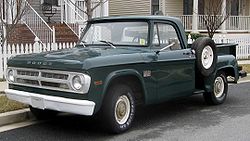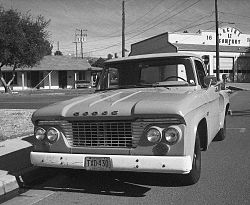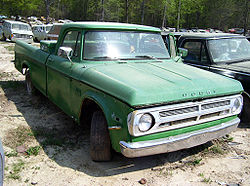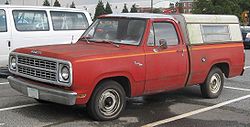- Dodge D Series
-
- For Dodge's modern full-size pickup, see Dodge Ram.
Dodge D Series 
Manufacturer Chrysler Also called Dodge Ram (1981–1993)
Dodge W-Series (4x4 models)
Dodge Power Ram (4x4 models from 1981–1993)Production 1961–1993 Assembly Warren, Michigan, United States
Buenos Aires, ArgentinaPredecessor Dodge C Series Successor Dodge Ram (newer platforms have "D" prefixed in its identity) Class Full-size pickup truck Body style 2-door truck
4-door truckLayout Front engine, rear-wheel drive / four-wheel drive Platform Chrysler AD platform First generation 
Production 1961–1964 Engine 170 cu in Slant-6 I6
225 cu in Slant-6 I6
426 cu in RB V8, 365 hp (272 kW) and 470 ft·lbf (637 N·m) gross
318 cu in A V8Transmission 3-speed push button automatic The D Series was a line of pickup trucks sold by the Dodge division of American automaker Chrysler from 1961-1980. After 1980, the trucks were renamed the Dodge Ram and the same basic design was retained until the 1994 introduction of a completely redesigned Ram. The D Series shared its AD platform with the Dodge Ramcharger/Plymouth Trailduster twins.
The body offered the then-traditional step-side bed, with distinct fenders as an option. As default, it introduced the first Virgil Exner-inspired "Swept-Line" bed where the bed was the width of the vehicle and the fenders were inboard, as can be seen in virtually all modern pickup trucks.
The D Series used the familiar Chrysler Slant 6 engine in displacements of 170 cu in, 198 cu in and 225 cu in as the base models, depending on the year. (The 198 was relatively rare, available as the base engine only from 1969–1973). All of Chrysler's larger engines, with the notable exception of the Chrysler Hemi engine were available as factory options.
Another innovation was the introduction of an alternator rather than a generator for electrical power. A three-speed automatic transmission was a major advance — the truck used a two-speed automatic less than a decade earlier.
Yet another innovation, a "Crew Cab" (four-door) body style was introduced in 1963, a first for a factory pickup. Prior crew cabs were custom conversion jobs. A "Club Cab" was also available for 1973, providing transverse seating for either a single third passenger or two small third and fourth passengers (most often, the Club Cab was used as extra cargo space).
In Argentina, was manufactured the first generation of the D-series. They were given the Dodge and Fargo brands, as Dodge D-100 and Fargo De Soto. They trucks was produced by the Argentinian subsidiary Chrysler-Fevre Argentina S.A.
Contents
Custom Sports Special and High Performance Package
1964 saw the introduction of the sporty Custom Sports Special. The Custom Sports Special included bucket seats, console, carpeting and racing stripes. The optional High Performance Package could be ordered with a CSS truck or by itself on a base model truck complete with Chrysler's big 426 cu in wedge-head V8. This engine produced 365 hp (272 kW) and 470 lb·ft (637 N·m) — in-line with the muscle car revolution that was then sweeping Detroit. The High Performance Package also included the LoadFlite automatic transmission, a 6000 rpm-rated Sun tachometer with heavy-duty gauges, power steering, dual exhaust and rear axle torque rods (traction bars) sourced from 1961 Imperials. Custom Sports Special trucks were produced from 1964-1967. The High Performance Package was only offered from 1964-early 1966.
1965
Second generation 
Production 1965–1971 Engine 170 cu in Slant-6 I6
225 cu in Slant-6 I6
318 cu in A V8
273 cu in LA V8
383 cu in RB V8, 258 hp (192 kW) and 375 lb·ft (508 N·m) gross
318 cu in LA V8, 160 hp (119 kW)Transmission 3-speed dash mounted or column mounted lever shifted automatic 1966 Fargo, sold only in Canada as a Dodge D Series clone.
The D Series was redesigned for 1965. Big news was a wider tailgate and the replacement of the A series engines with the updated LA series. In 1967, the D Series trucks received big-block 383 2-barrel engines as a standard option.
From 1965 until the early 80's, the D series were assembled by the Automotive Equipment Group (מכשירי תנועה בע"מ) in Israel at a new factory located at Nazareth-I'llit (תעשיות רכב נצרת-עלית), using straight 4 & 6 gasoline engines with manual transmission. This factory also produced the Jeep Wagoneer SUV for the Israeli army, and UK Ford Escort & Ford Transit vehicles for the civilian market. The D Series were made both for the civilian market and for the Israeli army. The models were D100 & D200 light trucks, D500 truck, and the D600 truck with the straight 6 engine and having on-demand 4 wheel drive. There was also a bus version made (mainly for army use). This bus was a 20 seat bus built on the chassis of the D500 truck using the straight 4 engine with front & rear hydraulic doors, complete D500 front end & hood, and D500 dashboard.[citation needed]
1968–1971
The 1968 models received a new front grille — two rows of four holes each. A new Adventurer trim package replaced the old Custom Sports Special; basically, it included a padded front seat with vinyl trim (either full bench or buckets with console) and carpeting, plus other hallmarks such as extra chrome trim and courtesy lighting.
By 1970, the Adventurer would be expanded into three separate packages: the base Adventurer, the Adventurer Sport and the top-line Adventurer SE. The Adventurer SE included such things as a chrome grille, wood trim on the dashboard, the padded vinyl front seat with color-keyed seatbelts, full courtesy lighting, extra insulation, dual horns, full carpeting, luxury door panel trim, a vinyl-embossed trim strip ran along the sides of the truck, full wheel discs and a woodgrain-insert panel on the tailgate. The 1970 models also featured a new four-section grille (two rows of two holes each).
'The Dude'
In August 1969, the "Dude Sport Trim Package" was released. This was essentially the D100 already in production, with an added black or white body-side ‘C’ stripe decal; a Dodge Dude decal on the box at the rear marker lamps; tail lamp bezel trim; and dog dish hub caps with trim rings. The Dude's tailgate was unique, featuring a Dodge decal on a flat tailgate surface, without the typical tailgate’s embossed logo. The Dudes were only offered in the 1970 and 1971 model years and only 1500 to 2000 Dudes were produced. [1][2]
1972–1980
Third generation 
Production 1972–1980 Engine 170 cu in Slant-6 I6
225 cu in Slant-6 I6
383 cu in RB V8, 258 hp (192 kW) and 375 lb·ft (508 N·m) gross
360 cu in LA V8, 180 hp (134 kW) net
400 cu in RB V8, 200 hp (149 kW) net
440 cu in RB V8, 235 hp (175 kW) net
243 cu in 6DR50A I6 Diesel 105 hp (78 kW) netTransmission 3-speed column shifted Automatic transmission A redesign of the D Series for 1972 that lasted until 1980 introduced a more rounded look, similar to the 1973-1987 GM C/K series. This redesign for the third generation, that spanned until 1993 with minor changes, included new features such as an independent front suspension and pocketed taillights (the distinctive reverse on top lights were recessed to .25 in (6.4 mm) to avoid damage in loading docks and confined spaces). Styling cues, such as the scalloped hood and rounded fenderwells, were similar to the rounded, smooth look of the 1971 Plymouth Satellite. These trucks were built with a considerable amount of galvanized steel to resist rust and corrosion making them very durable. Because of this, today these trucks make great restoration projects.
1972 also saw the introduction of the 440 cu in engine as a standard option for the light trucks.
The 1972 D Series was made famous in the television show Emergency!, where it was the featured paramedic rescue squad vehicle for the entire seven seasons of the popular show.
Notable models produced during this era were the 1978-1979 Li'l Red Express, the Warlock, the Macho Power Wagon and the Adventurer (Note: All Li'l Red Express Trucks were Adventurers, though not vice versa). Another rare model is the Midnite Express which was available for the 1978 model year only. This truck was equipped much like the Li'l Red Express with exhaust stacks, wheels, and gold pinstriping. The Midnite Express was painted black instead of red and featured a "Midnite Express Truck" decal on the door. Most Midnite Express trucks were powered by the 440 engine, instead of the 360 like the Li'l Red Express. All of these trucks were considered "lifestyle" pickups and were marketed to an audience that wanted specialty, personal use trucks. Dodge also saw a need in the market for a "Club Cab" pickup and released an extended cab version of the D Series with extra space behind the front seat while still having two doors on the cab — not to be confused with the much larger "Crew Cab" that had four doors.
The 1978 saw also the introduction of the first Diesel powered Dodge pickup truck. Available as an economy choice in the light duty trucks was Mitsubishi 6DR50A 4.0 L inline 6-cylinder naturally aspirating diesel, rated at 105 hp (78 kW) at 3500 rpm, and ~230 N·m (~169 lb·ft) @ 2200 rpm. The diesel used standard Dodge manual and automatic transmissions via specially made adapter plate which had the LA V8 bolt pattern. This rare factory option, VIN code H, was the result of fuel crisis and the collaboration of Chrysler and Mitsubishi. The engine, while being trustworthy and having far better economy than any other engine in the Dodge lineup at the time, suffered from its low power output and was considered to be underpowered by American standards, even though it was previously used in the Japanese 3.5-ton cab-over Mitsubishi T44 Jupiter Truck and in industrial applications. Because of the low sales it was phased out quickly and as a result it became practically a single year specialty.
Thousands of D Series trucks entered military service as the M880 series CUCV.
1981–1993
- Main category: Dodge Ram
This final generation was facelifted in 1981 when the D Series was rebadged as the Dodge Ram pickup around when Lee Iaccoca took charge of the ailing Chrysler Corporation. Such things including an embossed "DODGE RAM" name on the tailgate along with other obvious changes like the grille and hood, the taillights, and the entire interior. More subtle was the addition of a "shoulder" line reminiscent of the GM competition. Beginning in 1981, even more corrosion-resistant steel was used in the construction of the trucks. This bodystyle continued until 1993 and needless to say, many of these vehicles are on the road still. Many body panels are interchangeable for all models from 1972–1993, so it is not impossible to see a "hybrid" of a 1978 grille mounted with a 1974 hood and a 1991 cab. Sometimes, the bed is swapped with a moving truck style box for models like these. In most jurisdictions, the year is dictated by the year of the truck's chassis regardless of the body which has been bolted to it. Also kept was the Utiline step-side model that had the same truck bed that dated well into the 1940s. This was dropped during in this last era of the W/D Dodge trucks.
A narrower range of engines was offered: the base power plant was the 225 cu in (3.7 L) slant-6, now with top-fed hydraulic tappets, and the 318 cu in (5.2 L) and 360 cu in (5.9 L) LA-series V8s. The slant-6 was supplanted by the 3.9 L (237 cu in) V6 for 1988; in 1992 it and the V8s became Magnum engines. The 6BT 5.9 L (360 cu in) 12-Valve Cummins B Series diesel engine became an option in 1989.
Sales were good during the Sweptline era and into the late 1970s. A combination of stagnant styling nearly two decades old plus brand loyalty primarily to Chevrolet and Ford during the 1980s and 1990s reduced sales volume for the first generation Dodge Ram. A wholly new Dodge Ram was released for the 1994 model year.
Engines
- 1961-1969 170 cu in (2.8 L) Slant-6 I6
- 1961-1987 225 cu in (3.7 L) Slant-6 I6
- 1961-1966 318 cu in (5.2 L) A V8
- 1964 426 cu in (7.0 L) RB V8, 365 hp (272 kW) and 470 lb·ft (637 N·m) gross
- 1965 273 cu in (4.5 L) LA V8
- 1967-1979 383 cu in (6.3 L) B V8, 258 hp (192 kW) and 375 lb·ft (508 N·m) gross
- 1967-1993 318 cu in (5.2 L) LA V8, 160 hp (119 kW) net
- 1972-1993 360 cu in (5.9 L) LA V8, 180 hp (134 kW) net
- 1972-1979 400 cu in (6.6 L) B V8, 200 hp (149 kW) net
- 1974-1979 440 cu in (7.2 L) RB V8, 235 hp (175 kW) net
- 1978-1979 Mitsubishi 6dr50A 4.0-liter I6 naturally aspirated diesel,105 hp @ 3500 rpm, and 169 lb·ft (230 N·m) of torque @ 2200 rpm
- 1988-1993 239 cu in (3.9 L) LA V6, 180 hp (134 kW) and 195 lb·ft (264 N·m)
- 1989-1993 359 cu in (5.9 L) Cummins B Series engine I6, 160 hp (119 kW) and 400 lb·ft (542 N·m) of torque
In Brazil, it was marketed just with the 318 cu in (5.2 L) V8.
Dodge D-Series in Television/Movies
 Squad 51, 1972 Dodge D-300 Dualie V8, built by Universal Studios for Emergency!
Squad 51, 1972 Dodge D-300 Dualie V8, built by Universal Studios for Emergency!
- A 1972 Dodge D-300 was used as a LA County Fire Department paramedic rescue vehicle, aka Squad 51 in the television show Emergency!. The utility body was custom built by Universal Studios for Emergency! according to the Los Angeles County Fire Department's specifications for its paramedic rescue vehicles. It was then donated to the LA County Fire Museum and was then restored thoroughly in 1999. The only thing that changed in the restoration was, a diesel engine replaced the engine used previously. There were 3 Dodge D-series vehicles used in the filming of Emergency!, a 1971, 1972 and a 1973 Dodge D-300. The 1972 and the 1973 were identical except for the grilles.
- In the opening scene of National Lampoon's Christmas Vacation, the driver of a 1963 Dodge D200 harasses the Griswold family. The angry Mr. Griswold gets his car stuck under a lumber trailer.
- In the Supernatural episode "Route 666", a racist that a black man killed in self-defense in the 1960s haunts a town as a phantom D300. The vehicle is extensively modified, particularly through the addition of two diesel smokestacks, and filmed in such a way that identifying features are hard to see. The truck is most recognizable in a sequence where Sam and Dean Winchester pull the actual wreckage of the truck out of a pond.
- In 2009, an episode of Criminal Minds featured a black 1979 D-100 step-side as the vehicle driven by the villain (or unsub). The truck was the unsub's weapon of choice.
See also
- Fargo Trucks
External links
- Custom Sports Special REGISTRY(D-Series High Performance)
- 1961-71 Dodge Truck Website (Medium & Heavy Duty Trucks)
- Old Dodges.com (Medium & Heavy Duty Dodges)
Dodge / Ram truck timeline, North American market, 1970s–present Type 1970s 1980s 1990s 2000s 2010s 0 1 2 3 4 5 6 7 8 9 0 1 2 3 4 5 6 7 8 9 0 1 2 3 4 5 6 7 8 9 0 1 2 3 4 5 6 7 8 9 0 1 2 Mid-size crossover Journey Compact SUV Raider Nitro Mid-size SUV Durango Full-size SUV Ramcharger Ramcharger Durango Durango Coupé utility Rampage Compact pickup D-50 Ram 50 Ram 50 Mid-size pickup Dakota Dakota Dakota Full-size pickup D Series D Series Ram Ram Ram Ram Ram SRT-10 Minivan Caravan CV/GCV CV/GCV CV/GCV CV/GCV Grand Caravan Van A100 Tradesman Ram Van/Ram Wagon Ram Van/Ram Wagon Sprinter Sprinter Heavy-duty truck LCF/C Series Dodge Cars Vans / SUVs Historic 024 · 330 · 400 · 600 · 880 · Aries · Aspen · Avenger · Brisa · Caliber · Challenger · Charger (B-body) · Charger (L-body) · Charger Daytona · Colt · Conquest · Coronet · Custom 880 · Dart · Daytona · Demon · Diplomat · Dynasty · Intrepid · La Femme · Lancer · Matador · Mirada · Monaco · Neon · Omni · Phoenix · Polara · SE · Shadow · Sierra · Spirit · SRT-4 · St. Regis · Stealth · Stratus · Super BeeHistoric Vans / SUVs Corporate Fratzog · John Francis Dodge · Horace Elgin Dodge · Ram Truck Division · Category:Dodge vehicles · Chrysler LLCCategories:- 1960s automobiles
- 1970s automobiles
- 1980s automobiles
- All wheel drive vehicles
- Dodge vehicles
- Pickup trucks
- Rear wheel drive vehicles
Wikimedia Foundation. 2010.





